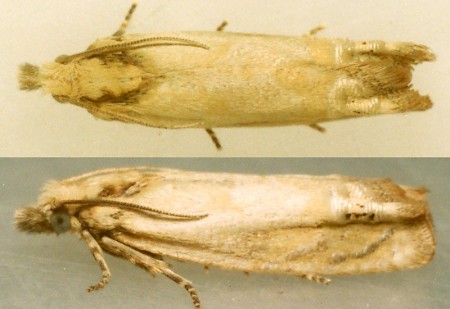Eucosma tripoliana

49.272 BF1193
Eucosma tripoliana
(Barrett, 1880)
Wingspan 13 - 17 mm
E. tripoliana flies in the late afternoon and night in July-August. It has been recorded in south and east England, South Wales, and from Flintshire to north Lancashire, on saltings where its foodplant, sea-aster (Aster tripolium), occurs.
E. rubescana also feeds on sea-aster, but it is larger (wingspan 16 mm - 20 mm) and greyish tawny with very indistinct markings. Occasionally a specimen of E. tripoliana has its markings, apart from the silvery strigulae and ocellus, obscured by a light yellowish suffusion.
The larva feeds from late August to October in flowers of sea-aster, often betraying its presence with frass on the flower head. It overwinters on the ground as a larva in a silk hibernaculum coated with detritus, and must be able to survive being covered by high tides.
Larva: (description Ian F. Smith)
Foodplant: Late August - October in a loose spinning among pappus hairs of a flower of Aster tripolium, feeding on the unripe seeds. November-May in silk hibernaculum covered in detritus fragments, on ground among debris.
Length: 9 mm and 10 mm described. (4 mm and 5 mm variations in brackets).
Head: (4mm/5mm black with red-brown mouthparts). Brown ochre, shaded blackish dorsally and posteriorly. Black posterolateral mark. Frons thinly outlined in black. Mouthparts reddish brown. Stemmata colourless, enclosed in black stemmatal area.
Prothoracic shield: (4mm/5mm pitchy brown). Translucent light greyish brown. Mottled pitchy brown laterally and at posterior. Divided by yellowish medial line with pitchy brown dots on its margins.
Thoracic legs: Coxa coloured as body, with black obtuse 'V' on anterior face. Outer faces of femur and tibia marked greyish. Base of femur thinly edged black. Tarsus translucent yellowish. Claw reddish brown.
Body: Moderately shagreened. Pale shade of brown ochre, slightly darker towards posterior. Paler ventrally. Slightly greyish faint dorsal line. (4mm/5mm reddish brown indistinct dorsal line.)
Spiracles: Pitchy black peritreme.
Pinacula: Indistinct and only discernible because lacking the shagreen of the integument. Unobtrusive, very fine blackish setal spot.
Setae: Colourless transparent.
Anal segment: No anal comb. Anal plate blotched yellowish white and greyish brown with blackish spotting.
Prolegs: Coloured as body. Crochets reddish brown.
Similar species: The larvae of many species of Eucosma are very similar. The only other Eucosma recorded on Aster tripolium in the British Isles is Eucosma catoptrana (Rebel), in the south and east of England from W. Sussex to S.E. Yorkshire (J. Langmaid, pers. comm.). It has a yellowish cream abdomen, tinged pink as the larva matures, and brown thoracic legs (BTS). As its imago is larger, so too, presumably, is the larva. It is earlier than E. tripoliana, leaving the foodplant to diapause by the end of August or early September.

 UKMoths
UKMoths 







